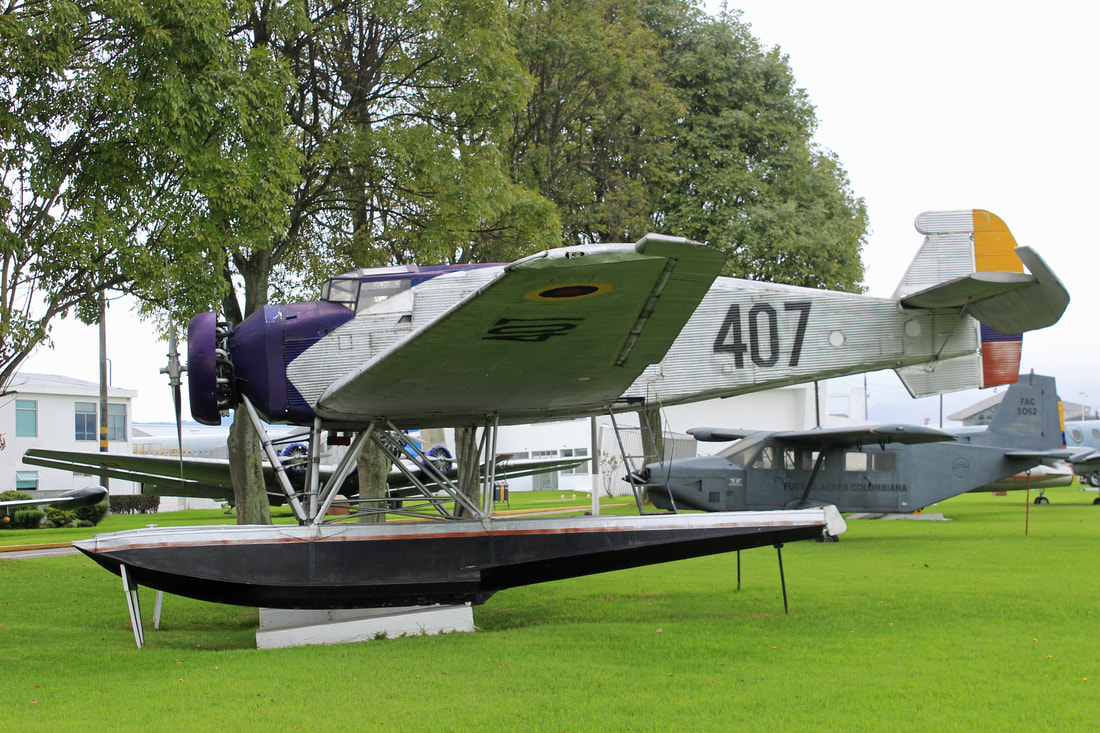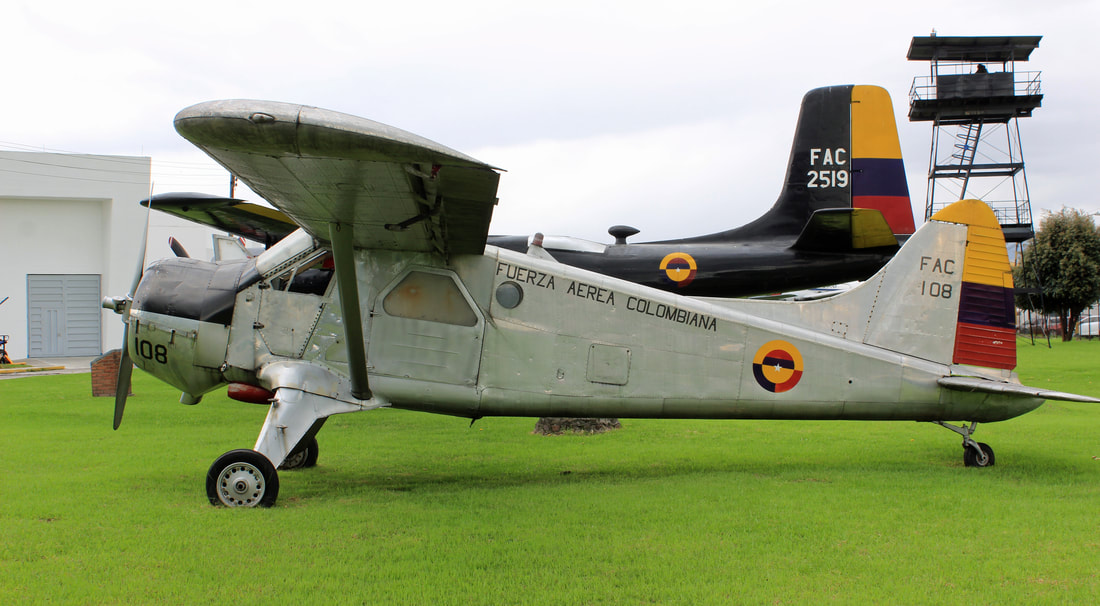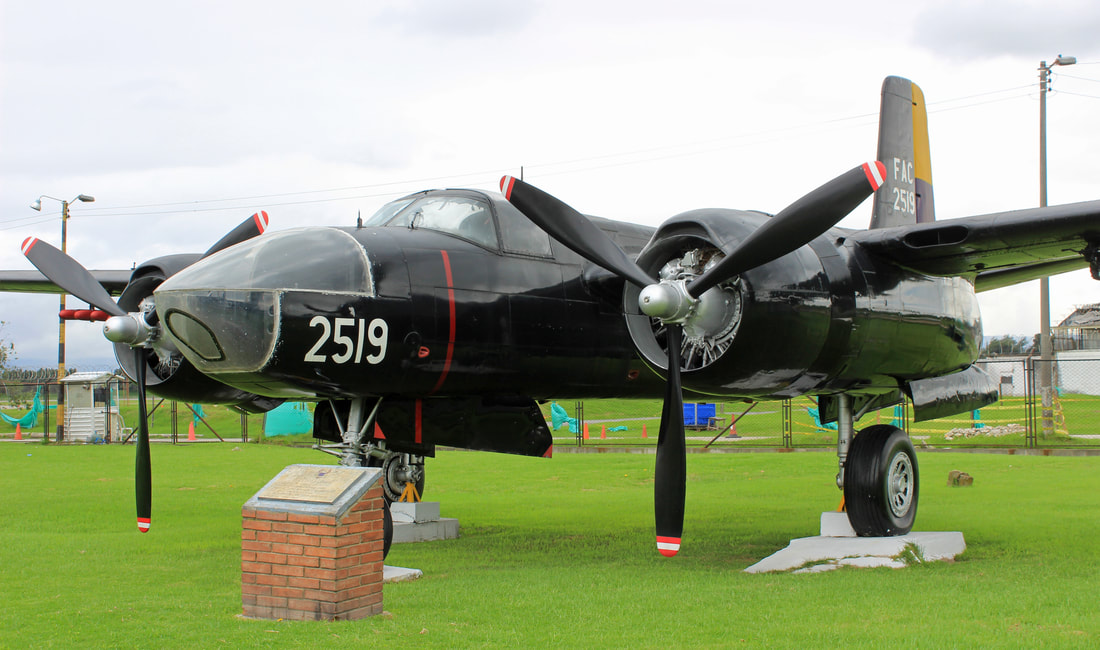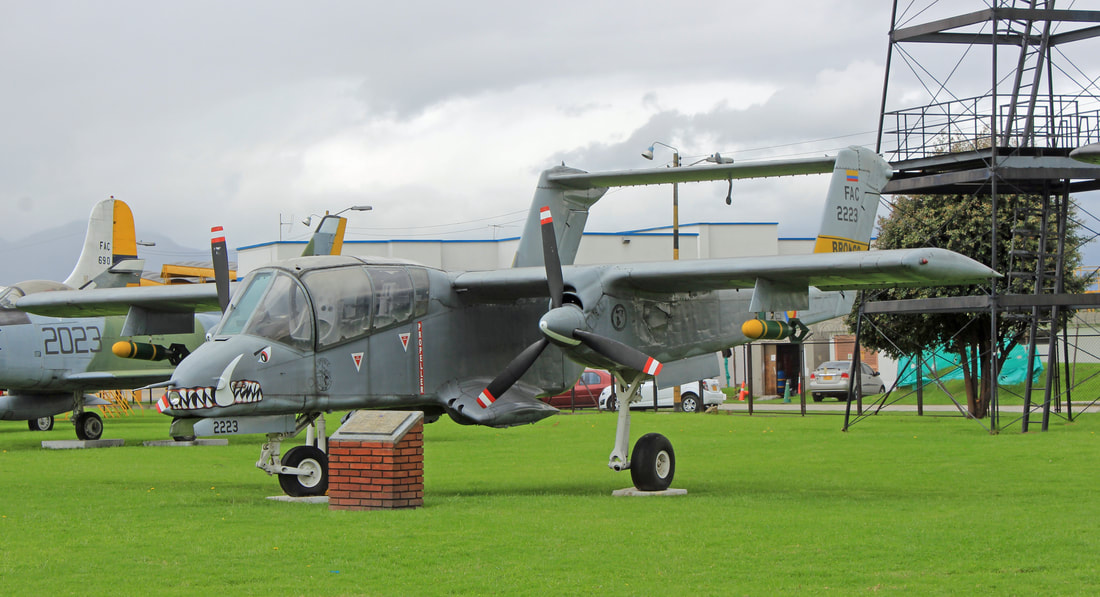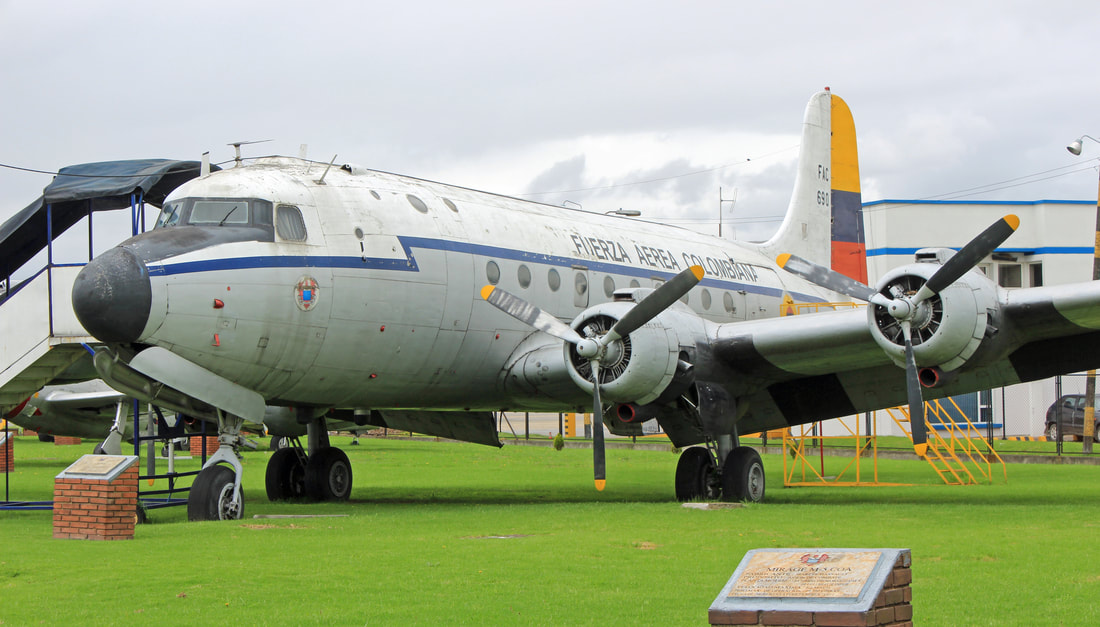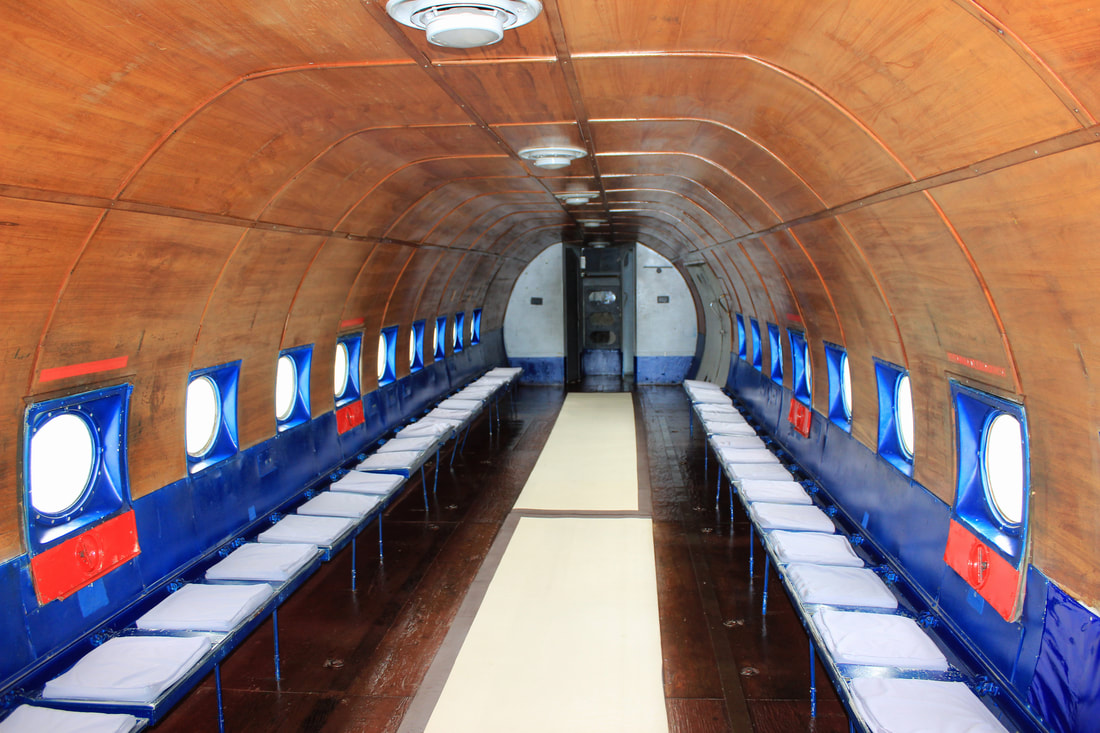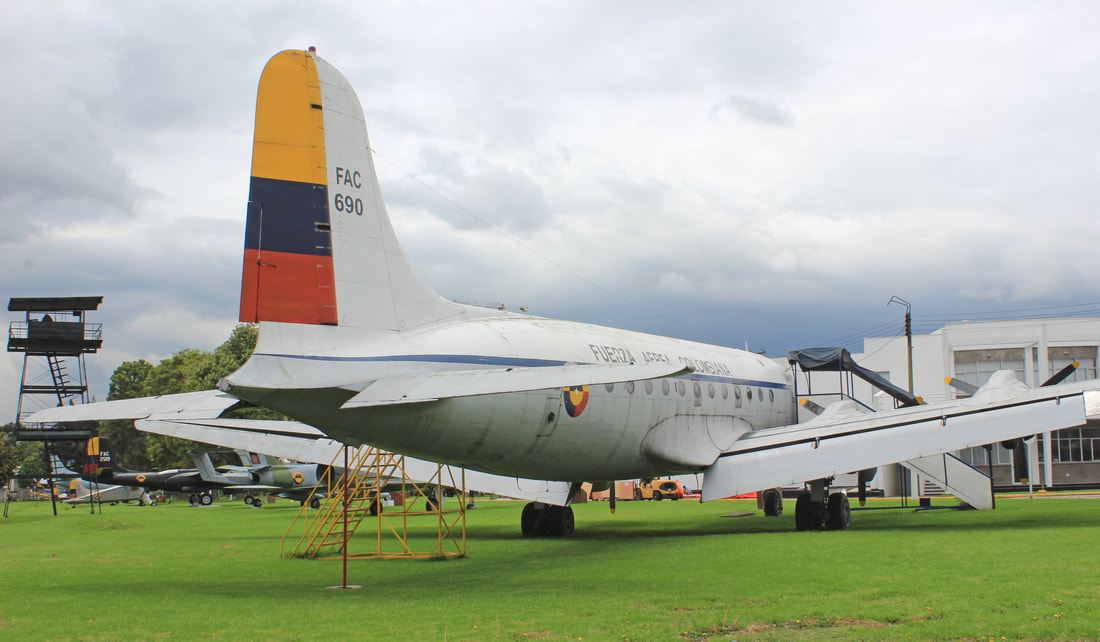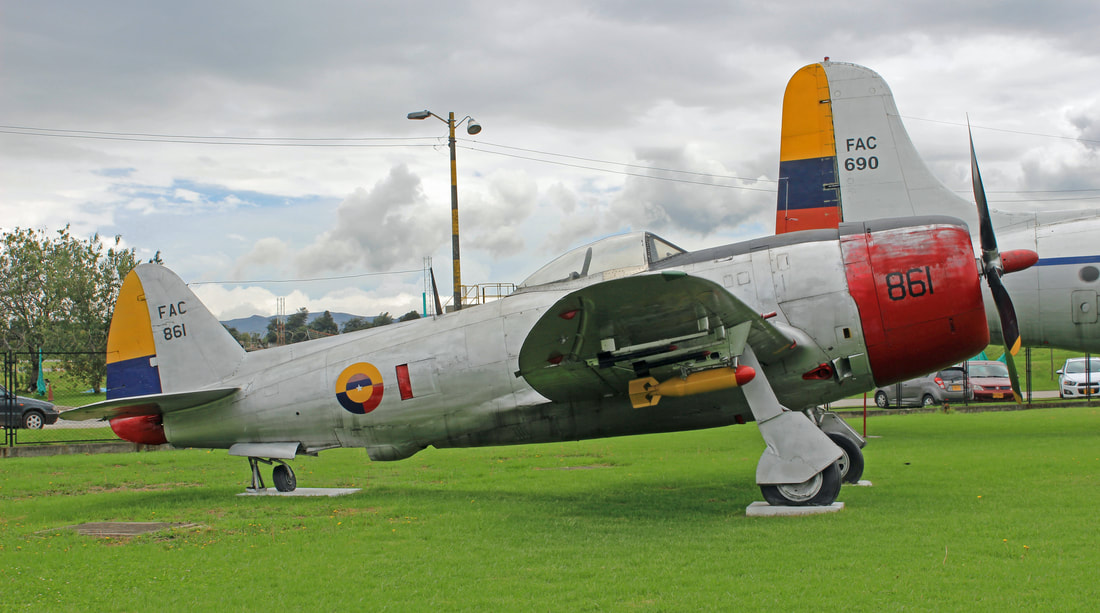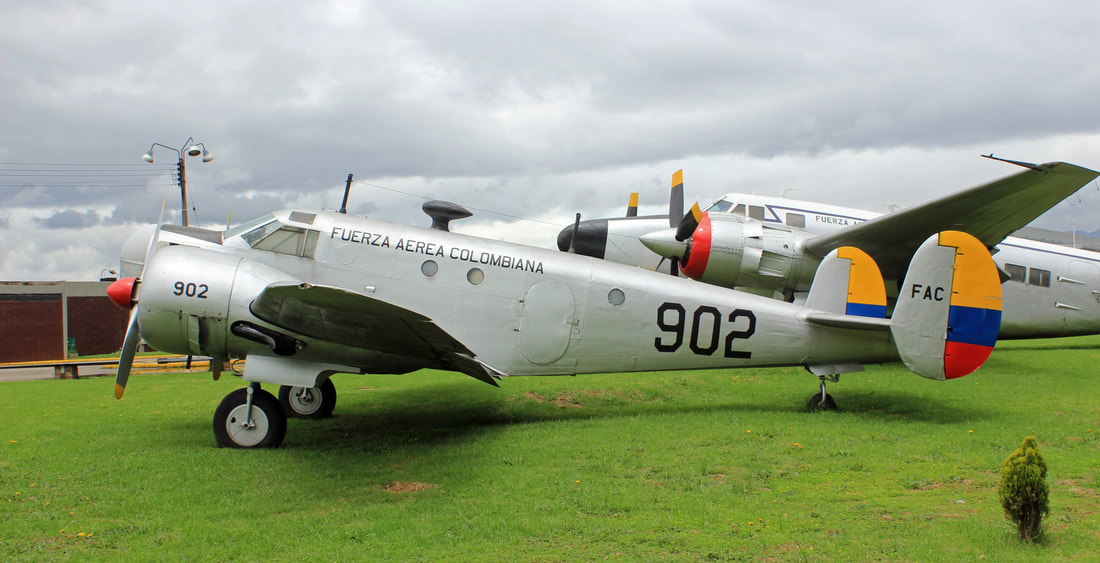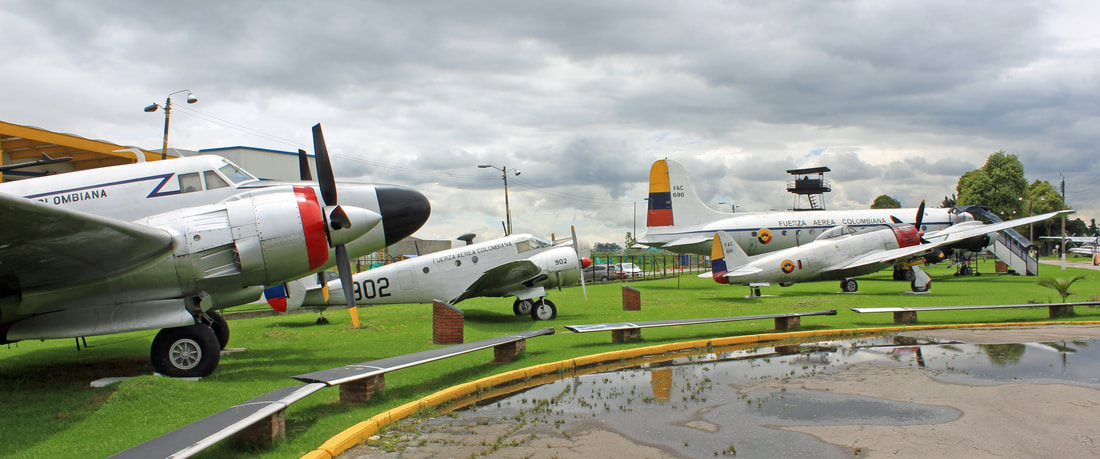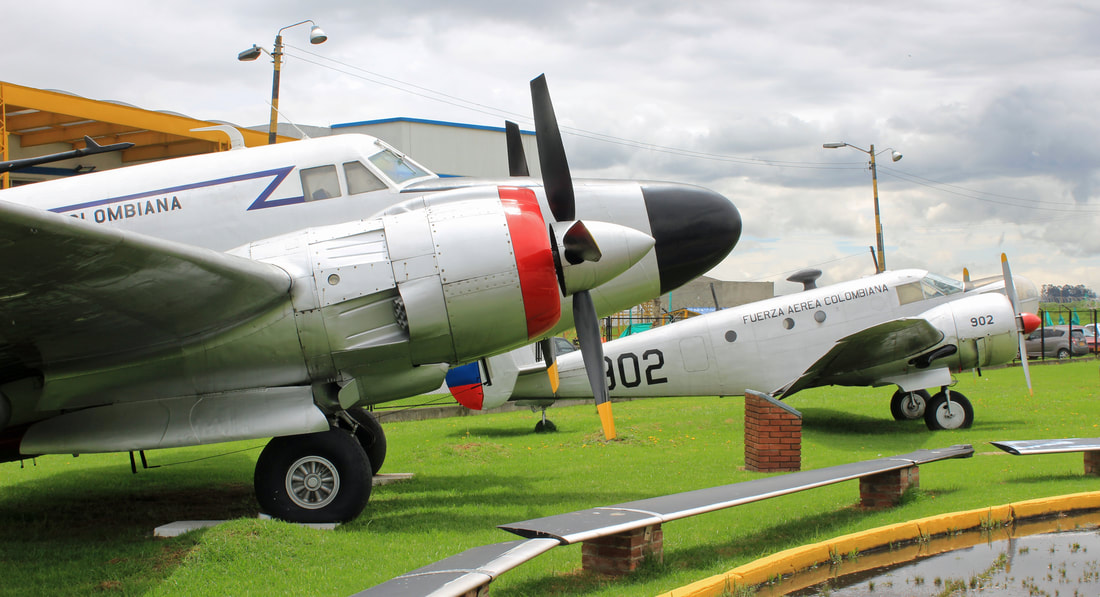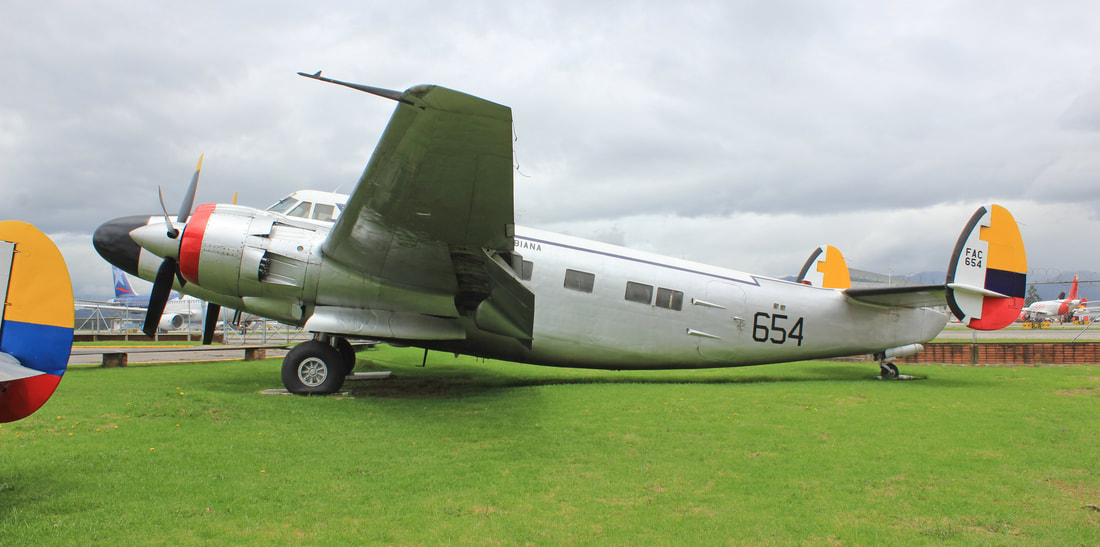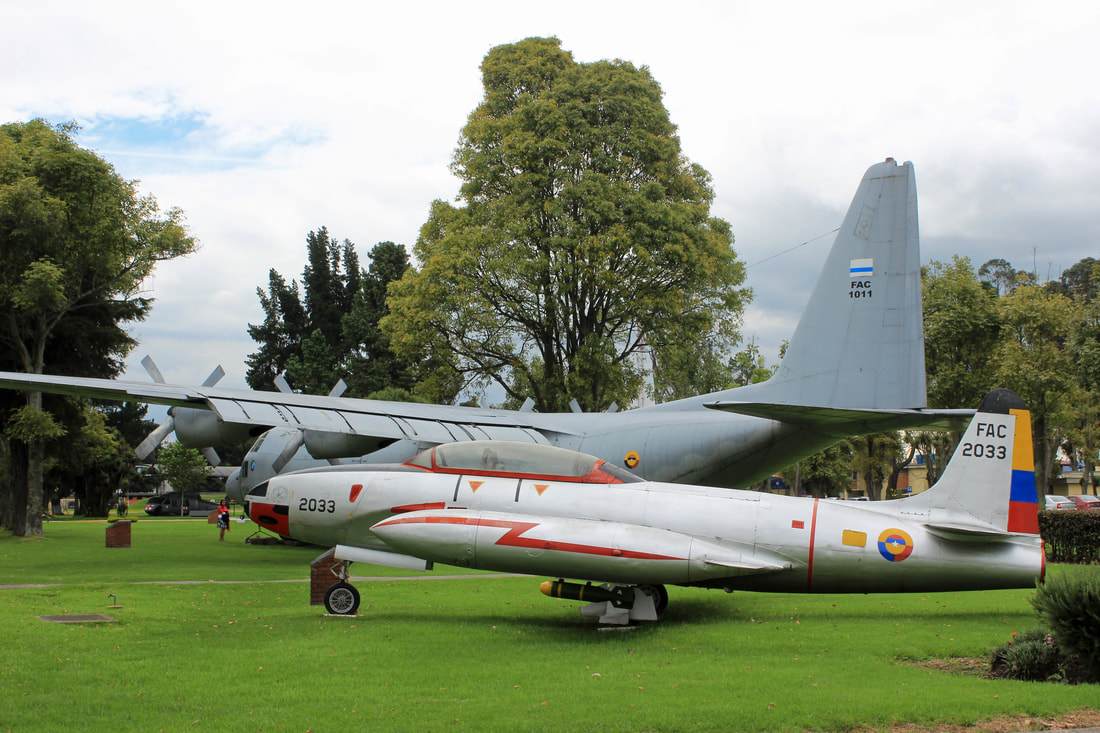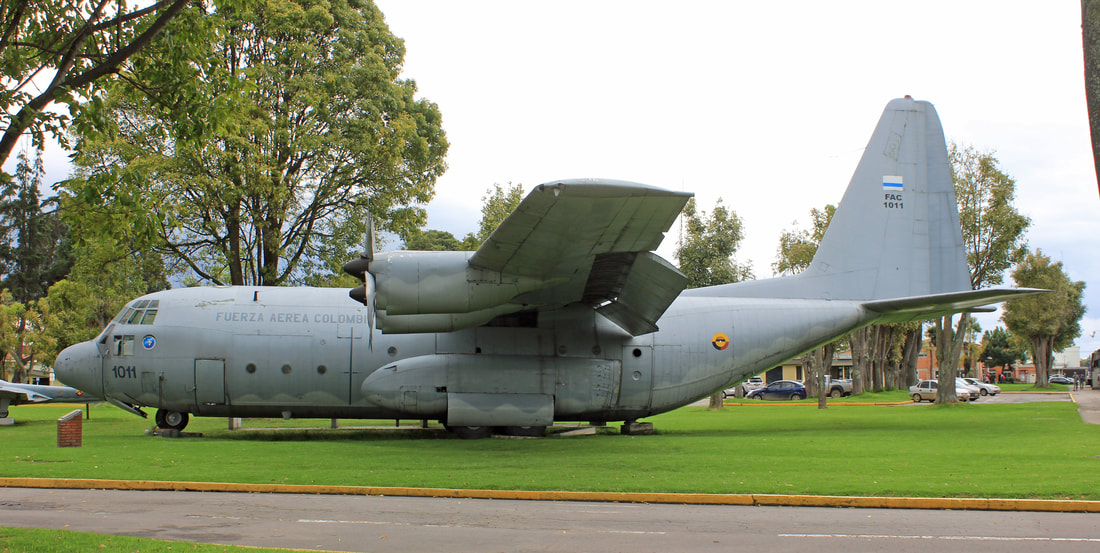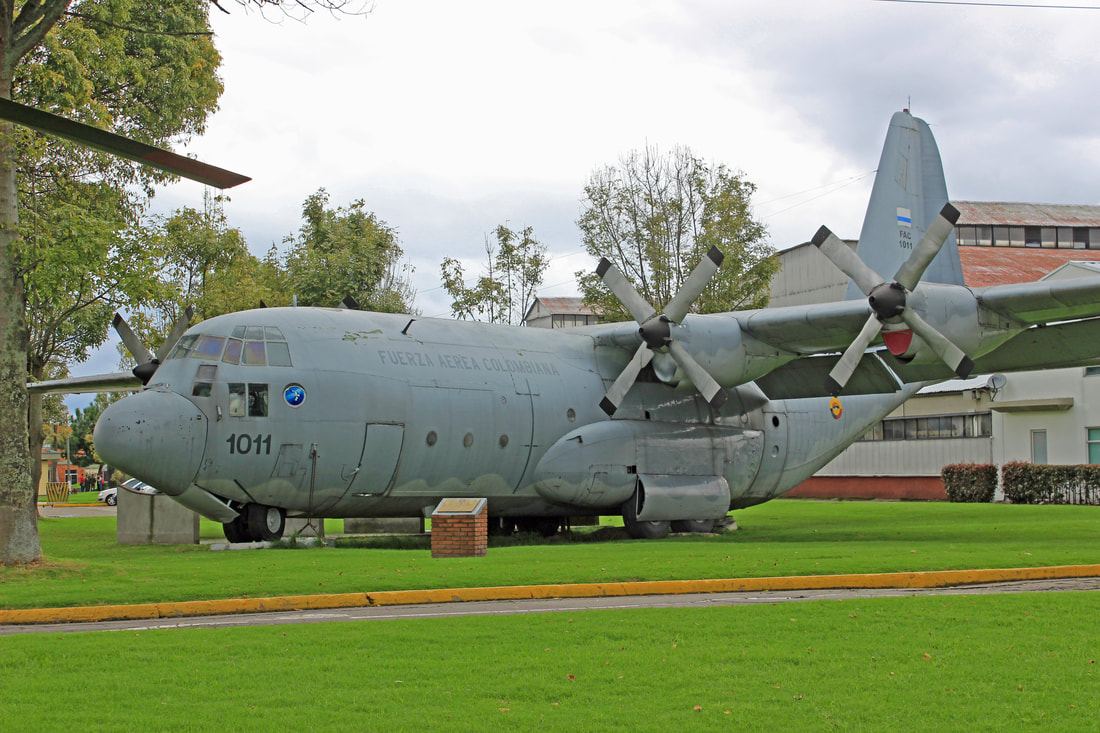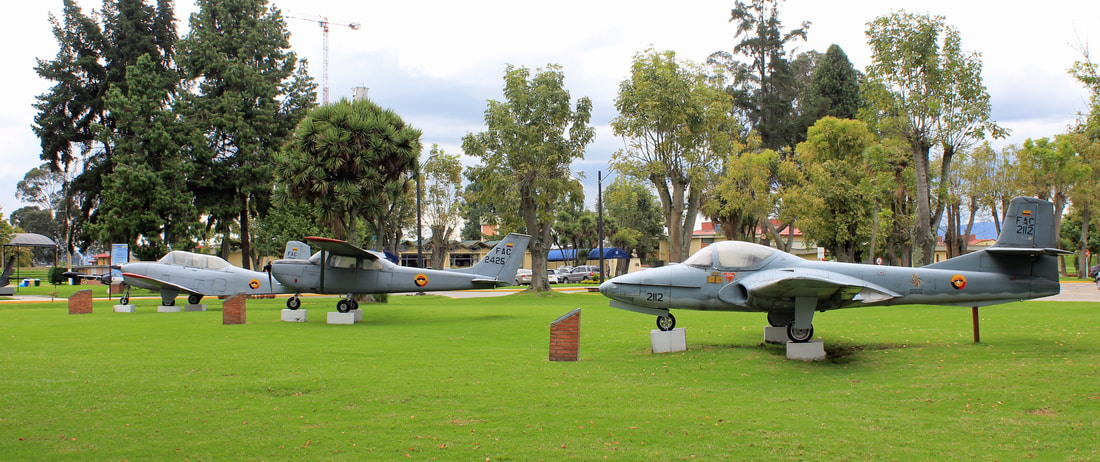Colombia Air Force Museum, Bogota
by Micheal S. Prophet (photo's) and Jan Koppen
In April 2015, my friend, Mr. Michael S. Prophet, and I traveled from Amsterdam to Colombia. KLM Royal Dutch Airlines brought us comfortably in one of their Big Jets, to Bogota-El Dorado.
During our spotters-trip in Colombia, we took the opportunity to visit the Museo Aeroespacial Colombiano, which was located on the grounds of the Colombian Air Force and located in the outskirts of Bogotá within the vicinity of El Dorado International Airport.
Enjoy the pics, video, and captions.
During our spotters-trip in Colombia, we took the opportunity to visit the Museo Aeroespacial Colombiano, which was located on the grounds of the Colombian Air Force and located in the outskirts of Bogotá within the vicinity of El Dorado International Airport.
Enjoy the pics, video, and captions.
Douglas DC-3C "FAC 667", is the Colombia Air Force Museum's gate guardian and is seen here with a great late morning light.
"FAC 667" being portrayed on a cloudy morning.
"FAC 667", came off the production line in the early 40's for delivery to the USAAF. After her military career she fluttered around the globe and finally ended up on display at the Museo Aeroespacial Colombiano.
The legendary DC-3.
Air Command for Military Transportation (English for Comando Aéreo de Transporte Militar, CATAM) is a major military airfield for the use of the Colombian Air Force. Is located in the outskirts of Bogotá within the vicinity of El Dorado International Airport.
The museum has to inform the public part of the institutional history, see planes that have been in service over the 85-year history of the Colombian Air Force and establish a closer bond between the community and the Air Force.
Bell B.47G-2 "FAC 206".
Bell UH-1B Iroquois 'Huey' with serial "FAC 4272".
Hiller Raven OH-23B "220".
North American AT-6D Texan "772" looks to be in superb condition.
Man-made beauty!
Hughes H.369E "4251".
Junkers JU-W34 "407".
The Junkers W-34 was a German-built, single-engine, passenger and transport aircraft. Developed in the 1920s, it was taken into service in 1926. The passenger version could take a pilot and five passengers. The aircraft was developed from the Junkers W 33. Her Powerplant was 1 × BMW 132A 9-cylinder air-cooled radial piston engine, 480 kW (650 hp).
Gavilan G.358M "5067".
The Gavilán 358 (English: Sparrow Hawk) is a Colombian light utility transport aircraft of the 1990's. A high-winged monoplane powered by a piston engine. Small numbers of Gaviláns were produced in the late 1990's/early 2000's, some served with the Colombian Air Force.
Your author and our charming guide.
Lockheed P-80C Shooting Star "FAC 2061".
The Lockheed P-80 Shooting Star was the first jet fighter used operationally by the United States Army Air Forces (USAAF). Designed and built by Lockheed in 1943 and delivered just 143 days from the start of the design process, production models were flying, and two pre-production models did see very limited service in Italy just before the end of World War II. Designed with straight wings, the type saw extensive combat in Korea with the United States Air Force (USAF) as the F-80.
America's first successful turbojet-powered combat aircraft, it helped usher in the "jet age" in the USAF, but was outclassed with the appearance of the swept-wing transonic MiG-15 and was quickly replaced in the air superiority role by the transonic F-86 Sabre. The F-94 Starfire, an all-weather interceptor on the same airframe, also saw Korean War service. The closely related T-33 Shooting Star trainer would remain in service with the U.S. Air Force and Navy well into the 1980s, with the last NT-33 variant not retired until April 1997. Many T-33s still serve in a military role in foreign air arms or are in private hands, although the F-80 itself has long been retired from active service.
America's first successful turbojet-powered combat aircraft, it helped usher in the "jet age" in the USAF, but was outclassed with the appearance of the swept-wing transonic MiG-15 and was quickly replaced in the air superiority role by the transonic F-86 Sabre. The F-94 Starfire, an all-weather interceptor on the same airframe, also saw Korean War service. The closely related T-33 Shooting Star trainer would remain in service with the U.S. Air Force and Navy well into the 1980s, with the last NT-33 variant not retired until April 1997. Many T-33s still serve in a military role in foreign air arms or are in private hands, although the F-80 itself has long been retired from active service.
The weather at Museo Aeroespacial Colombiano was gray, wet and dark.
Swearingen Metro SA.227 "1240".
"FAC 108" is a 1952 built De Havilland U-6A/DHC-2 .
Several replacement skin parts can be seen on this DHC-2 cockpit door.
This view accentuates the ruggedness of the DHC-2 Beaver.
Douglas A-26C "FAC 2519" was build in '44.
Absolute stunner!
An eye-catching Big-Prop!
The Douglas A-26 Invader (designated B-26 between 1948 and 1965) is an American twin-engined light bomber and ground attack aircraft. Built by Douglas Aircraft Company during World War II, the Invader also saw service during several major Cold War conflicts. A limited number of highly modified United States Air Force aircraft served in Southeast Asia until 1969. It was a fast aircraft capable of carrying a large bomb load. A range of guns could be fitted to produce a formidable ground-attack aircraft.
A re-designation of the type from A-26 to B-26 led to confusion with the Martin B-26 Marauder, which first flew in November 1940, some 20 months before the Douglas design's maiden flight. Although both types were powered by the widely used Pratt & Whitney R-2800 Double Wasp eighteen-cylinder, double-row radial engine, they were completely different and separate designs – the Martin bomber originated in 1939, with more than twice as many Marauders (nearly 5,300) produced in comparison to the Douglas design.
A re-designation of the type from A-26 to B-26 led to confusion with the Martin B-26 Marauder, which first flew in November 1940, some 20 months before the Douglas design's maiden flight. Although both types were powered by the widely used Pratt & Whitney R-2800 Double Wasp eighteen-cylinder, double-row radial engine, they were completely different and separate designs – the Martin bomber originated in 1939, with more than twice as many Marauders (nearly 5,300) produced in comparison to the Douglas design.
North American Rockwell OV-10A Bronco "2223", with some storm clouds brewing.
The North American Rockwell OV-10 Bronco is an American twin-turboprop light attack and observation aircraft. It was developed in the 1960's as a special aircraft for counter-insurgency (COIN) combat, and one of its primary missions was as a forward air control (FAC) aircraft. It can carry up to 3,200 lb of external munitions, internal loads such as paratroopers or stretchers, and loiter for three or more hours.
A great looking brute, the Bronco.
"2023" is a Canadair CL-13B Mk.6 Sabre.
The Canadair Sabre is a jet fighter aircraft built by Canadair under licence from North American Aviation. A variant of the North American F-86 Sabre, it was produced until 1958 and used primarily by the Royal Canadian Air Force (RCAF) until replaced with the Canadair CF-104 in 1962. Several other air forces also operated the aircraft.
"FAC 3027" is a Dassault Mirage-5COA.
The Mirage-5COA is an export version of the Mirage 5 for Colombia. Only 14 built were built.
Douglas DC-4-1009 "FAC 690".
Stains caused by rain persist as seen here streaking down from the roundel and cockpit window.
This DC-4 is standing outside for years at the Colombia Air Force Museum in Bogota, seemingly without any attention. Dirt has gathered in all the panel lines showing most clearly around the wing fearings.
Welcome aboard!
Douglas DC-4 1009 "FAC 690", which was manufactured in 1946, enjoyed a long and various career. She operated respectively for SILA and Scandinavian Airlines Systems (SAS) in Sweden. In 1954 she was sold to the Colombian Air Force and became the presidential aircaft between 1954 and 1972. In the mid 80;s she was withdrawn from use and presently she on display in the Museum.
The DC-4-1009 was a postwar passenger model. This civil model could carry up to 88 passengers.
Capturing the atmosphere of an overcast Colombian day, which is slowly turning to rain.
What a nice overview of Colombia's past and present aviation!
'Barndoors' of flaps.
An airplane stored outside will be subject to streaking down the paintwork from dust and dirt deposits unless washed regularly.
Republic P-47D Thunderbolt "FAC 861".
Paint has also chipped away along panel edges as a result of wear from the constant removal and replacement of the panels by the ground crews.
The Republic P-47 Thunderbolt was a World War II-era fighter aircraft produced by the United States from 1941 through 1945. Its primary armament was eight .50-caliber machine guns, and in the fighter-bomber ground-attack role it could carry five-inch rockets or a bomb load of 2,500 pounds (1,103 kg). When fully loaded, the P-47 weighed up to eight tons, making it one of the heaviest fighters of the war. The P-47 was designed around the powerful Pratt & Whitney R-2800 Double Wasp engine.
Ice, hail and rain have battered away the paint from the motor cowling, making this workhorse look a little the worse for wear.
Beechcraft Beech AT-11 Kazan "902".
The Beechcraft AT-11 Kansan was a bombing and gunnery trainer for USAAF derived from AT-7, fuselage had small, circular cabin windows, bombardier position in nose, and bomb bay; gunnery trainers were also fitted with two or three .30-caliber machine guns, early models (the first 150 built) had a single .30-cal AN-M2 in a Beechcraft-manufactured top turret, later models used a Crocker Wheeler twin .30-cal top turret, a bottom tunnel gun was used for tail gunner training, 1,582 built.
Crystal clear image on a very dull day too!
"902", resplendent in its polished, natural metal finish.
An astoundingly beautiful Howard 400 with serial "654".
Built for the US Navy as a Lockheed PV-1 Ventura, this aircraft has a long history of registrations: RCAF2244, N1206, N5034F, N1970H, N197RD, N100LR, N400MC and YV-183CP. Now it is preserved at the Colombian Air Force Museum with fake registration FAC654 and pretending to be the presidential Lodestar.
Spit and polish! This immaculate Howard 400 was used by high ranking officials in the '60s.
The Howard 400 & 500's were the ultimate piston Bizplanes.
An eye-catching piston-propliner.
DC-3 expert, Mr. Michael S. Prophet and your author being portrayed in front of the Howard 400.
Junkers JU-52/3mde "625".
"625", which was manufactured in 1934 was the presidential aircaft between 1934 and 1950, after which she was withdrawn from use. Presently she on display in the Museum.
Lockheed T-33A Shooting Star "FAC 2033".
The Lockheed T-33 Shooting Star (or T-Bird) is a subsonic American jet trainer. It was produced by Lockheed and made its first flight in 1948. The T-33 was developed from the Lockheed P-80/F-80 starting as TP-80C/TF-80C in development, then designated T-33A. The last operator of the T-33, the Bolivian Air Force, retired the type in July 2017, after 44 years of service.
Lockheed C-130B "1011" is an oldie. She was built in 1959.
"FAC 1011" still manages to look majestic despite her age.
Cessna T-37B-CE Tweet "FAC-2112".
"FAC 2425" is a pretty little Cessna T-41D Mescalero.
Beechcraft Beech T-34 Mentor "FAC 318".
Please mind; - The aviation museum moved to a location across from Jaime Duque Park, near Tocancipa, Cundinamarca (North of Bogota) where it opened in November 2017.
- The End -













